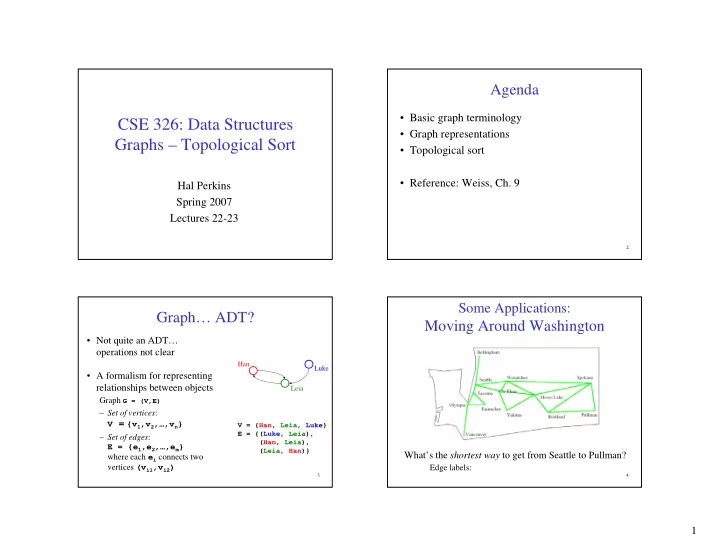

Agenda • Basic graph terminology CSE 326: Data Structures • Graph representations Graphs – Topological Sort • Topological sort • Reference: Weiss, Ch. 9 Hal Perkins Spring 2007 Lectures 22-23 2 Some Applications: Graph… ADT? Moving Around Washington • Not quite an ADT… operations not clear Han Luke • A formalism for representing relationships between objects Leia Graph G = (V,E) – Set of vertices : V = {v 1 ,v 2 ,…,v n } V = {Han, Leia, Luke} E = {(Luke, Leia), – Set of edges : (Han, Leia), E = {e 1 ,e 2 ,…,e m } (Leia, Han)} What’s the shortest way to get from Seattle to Pullman? where each e i connects two vertices (v i1 ,v i2 ) Edge labels: 3 4 1
Some Applications: Some Applications: Moving Around Washington Reliability of Communication What’s the fastest way to get from Seattle to Pullman? If Wenatchee’s phone exchange goes down , Edge labels: can Seattle still talk to Pullman? 5 6 Some Applications: Graph Definitions Bus Routes in Downtown Seattle In directed graphs, edges have a specific direction: Han Luke Leia In undirected graphs, they don’t (edges are two-way): Han Luke Leia If we’re at 3 rd and Pine, how can we get to v is adjacent to u if (u,v) ∈ E 1 st and University using Metro? 7 8 2
More Definitions: Trees as Graphs Simple Paths and Cycles A simple path repeats no vertices (except that the first can be the last): A • Every tree is a graph! p = {Seattle, Salt Lake City, San Francisco, Dallas} p = {Seattle, Salt Lake City, Dallas, San Francisco, Seattle} • Not all graphs are trees! B C A cycle is a path that starts and ends at the same node: A graph is a tree if D E F p = {Seattle, Salt Lake City, Dallas, San Francisco, Seattle} p = {Seattle, Salt Lake City, Seattle, San Francisco, Seattle} – There are no cycles (directed or undirected) G H A simple cycle is a cycle that repeats no vertices except – There is a path from the that the first vertex is also the last (in undirected root to every node graphs, no edge can be repeated) 9 10 Directed Acyclic Graphs (DAGs) Graph Representations Han Luke DAGs are directed main() 0. List of vertices + list of edges graphs with no Leia 1. 2-D matrix of vertices (marking edges in the cells) (directed) cycles. “adjacency matrix” mult() 2. List of vertices each with a list of adjacent vertices add() “adjacency list” Aside: If program call- graph is a DAG, then all Vertices and edges Things we might want to do: procedure calls can be in- may be labeled read() access() • iterate over vertices lined • iterate over edges • iterate over vertices adj. to a vertex 11 12 • check whether an edge exists 3
Weighted Edges Representation 1: Adjacency Matrix • adjacency matrix : ∈ ⎧ A |V| x |V| array in which an element weight , if (u, v) E = ⎨ A[u][v] ∉ ⎩ (u,v) is true if and only if there is an edge 0 , if (u, v) E from u to v 1 2 3 4 Han Luke Leia 1 Han 1 2 Han Luke 2 Luke Leia 3 Leia 4 3 4 space requirements: runtime: 13 14 Representation Representation 2: Adjacency List • adjacency list: A |V| -ary list (array) in which each entry stores 1 2 a list (linked list) of all adjacent vertices Han Han 3 Luke 4 Luke Leia 1 Leia 2 3 4 2 3 3 4 1 2 space requirements: runtime: 15 16 4
Application: Topological Sort Topological Sort: Take One Given a directed graph, G = (V,E) , output all the vertices in V such that no vertex is output before any other vertex with an edge to it. 1. Label each vertex with its in-degree (# of inbound edges) 2. While there are vertices remaining: CSE 403 CSE 321 CSE 322 Choose a vertex v of in-degree zero ; output v a. CSE 421 b. Reduce the in-degree of all vertices adjacent to v CSE 326 CSE 142 CSE 143 CSE 341 c. Remove v from the list of vertices CSE 451 CSE 370 CSE 467 CSE 378 Runtime: Is the output unique? 17 18 Topological Sort: Take Two void Graph::topsort(){ Vertex v, w; 1. Label each vertex with its in-degree labelEachVertexWithItsIn-degree(); 2. Initialize a queue Q to contain all in-degree zero vertices for (int counter=0; counter < NUM_VERTICES; counter++){ 3. While Q not empty v = findNewVertexOfDegreeZero(); a. v = Q .dequeue; output v b. Reduce the in-degree of all vertices adjacent to v v.topologicalNum = counter; c. If new in-degree of any such vertex u is zero for each w adjacent to v Q .enqueue( u ) w.indegree--; Note: could use a stack, list, set, } box, … instead of a queue } Runtime: 19 20 5
void Graph::topsort(){ Example Queue q(NUM_VERTICES); int counter = 0; Vertex v, w; labelEachVertexWithItsIn-degree(); CSE 403 q.makeEmpty(); CSE 321 CSE 322 intialize the for each vertex v queue CSE 421 CSE 326 if (v.indegree == 0) CSE 142 CSE 143 CSE 341 q.enqueue(v); CSE 451 CSE 370 while (!q.isEmpty()){ get a vertex with CSE 467 v = q.dequeue(); CSE 378 indegree 0 v.topologicalNum = ++counter; for each w adjacent to v if (--w.indegree == 0) insert new Q: eligible q.enqueue(w); vertices } } Output: Runtime: 21 22 6
Recommend
More recommend